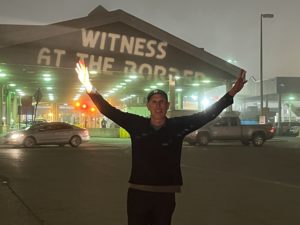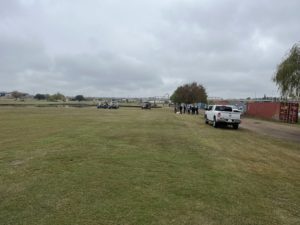Two boys drove me down to the border this month. At the Port Authority Bus Terminal set up by the border by Texas Governor Abbot, I saw a ten-month-old who was kept warm by only a Church World Service blanket. His mom, who might be from Venezuela, wore a light dress on a cold fall day. She was focused only on looking for clothes for her boy. We had none to offer her. An hour and a half later, a box of onesies came in, but mother and child were long gone by then. My one-month-old grandson already had more clothes than he could possibly use. Tears were in my eyes for a world where one boy will have all he needs, and another boy has so little of what he needs.
I was at the Port Authority through work with activists in New York who introduced me to “Witness at the Border,” a group that pays attention to what goes on down there. Their Journey for Justice was a drive from the Gulf of Mexico at Brownsville, Texas, to the Pacific Ocean in San Diego, California. I drove to Brownsville to join them. A U.S. Army veteran named Jesse was there to bless us on our journey. He was part of a Native people who lived on the Rio Grande long before the Spanish came. Who’s legal and illegal on the land? It is enough to make you cry.
We witnessed the intensity of the border, where there is more military presence than anywhere else in the country. At the crossing of Eagle Pass, Texas, and Piedras Negras, Mexico, we came upon a “military operation” where young National Guard soldiers with AR-17s and extra ammo clips on their belts traveled in camouflaged armored personnel carriers. They were detaining people who swam across the Rio Grande and surrendered themselves to the troops. A woman who had crossed the border was crying. When a videographer who was with our group asked why she was crying, she said they were tears of joy because she could not believe she had made it to America.
I come from a family of refugees that came over on the Mayflower. I can only imagine that my many-great grandfather Samuel Fuller, age 12, must have wept as a boy when they made it to Plymouth Rock. In years to come, it would be those who greeted them who would weep the most.
As I left the border on my way back to New York, the December full moon was going down in the morning over Mexico. I had seen much brutality, but also much beauty. There were murals painted for Uvalde victims that now line the streets of that town. There was Xan, who fuels her box truck on vegetable oil and goes around the country working for justice. There was Rachna, an Indian grandmother from Queens who showered love and cookies on everyone she met. There was Josh from Brooklyn, who stood for days outside of Matamoras and Homestead when families were being separated, to witness what was happening. There are tears of joy for those having made it to America and hope that we can do better.
The lectionary invites us to witness the story of refugees on the run to Egypt. Herod’s wrath is poured out on the baby boys of Bethlehem. Rachel weeps for her children, but the hope of Israel makes it across the border. In these two stories is the reality of our world: the brutality and the beauty, the despair, and the hope.
It’s a long drive from Bethlehem to Brownsville. There are a lot of tears on that trail. There is plenty to make you cry, but there is plenty to make you hope. I saw people willing to make a stand and willing to lend a hand. I saw people willing to swim toward hope and people willing to stand for hope. Herod will have his say, but he will not have the last word. Jesus made it across the border. I pray for both boys who drove me to the border, that they both may have enough–enough food, shelter, and clothing and enough hope in a better world. I don’t come back from the border with all the answers, but I do have hope.
Taylor W. Holbrook is the coordinator of the Duchess Interfaith CROP Hunger Walk.
CWS is committed to welcoming our new neighbors with warm hearts and helping hands. Through our Kits and Blankets program and the network of shelters we partner with along the U.S.-Mexico border, we provide migrants, refugees and asylum seekers the supplies they need and the reminder that we are here to help. In every step of the way, CWS ensures that a migrant’s journey is one of dignity and safety. To learn more about our migration, asylum and refugee programs click here.



